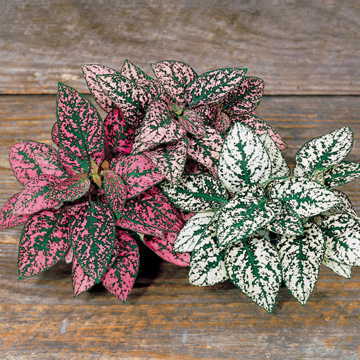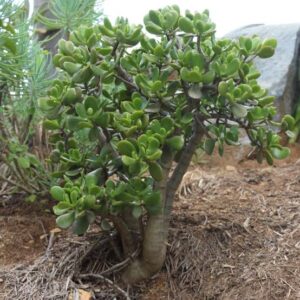The Polka Dot plant is a small and colorful plant native to Madagascar. It commonly comes in 2″, 4″, or 6″ pots. The green leaves are covered in spots and splashes of white, red, rose, or light green. Some varieties have pink leaves with green patches.

Polka Dots Plant profile
The leaves look has been painted with a sprayer. The Polka Dot plant is a member of the Hypoestes species. There are more than 100 varieties of the plant. When growing outdoors it is a perennial plant. A mature and established plant becomes woody and spindly.
Common name
The plant has a scientific name Hypoestes Phyllostachya. It has common names Polka Dot Plant and Freckle Face Plant because of its appearance.
Growth and size
The Polka Dots plant has a rather has a fast growth rate. It can grow fast from seed and need only 12 weeks to be ready for relocation to the garden.
Most Polka Dots plants can reach six to 10 inches tall. It can spread out six to 10 inches also.
Under ideal conditions, this Hypoestes Phyllostachya (Family Acanthaceae) plant species grows up to 30 inches high and wide.
Usage
The Polka Dot plant can be grown as a houseplant indoors. Even though they are small, they are charming to look at. The leaves create an interesting contrast between other plants.
The Hypoestes Phyllostachya plant can be utilized as an accent plant in patio containers, window boxes, dish gardens. The plant can be as a bedding plant to add some color in a partially shaded spot.
Flowers
The Polka Dots plant produces flowers during the summer and fall months. The flowers are spike-like racemes of small, tubular blue or pink flowers. The flowers are not delightful to look at so it is not interesting to see.
How to grow
Light requirement
The best light condition for the Polka Dot plant for growing the best result is in bright, filtered light. Even so, the plant can tolerate some sunlight.
The Polka Dot plants will produce better leaves color when placed in partial shade than full sun. With a very low light or no light at all, the leaves color fade out.
By keeping the plant to have indirect light, the colors of the plant look vibrant. The indirect light will also prevent the plant from becoming ungracefully thin and tall.
A location with too bright light will also fade out the foliage colors. Relocate the Polka Dot Plant 3 to 4 feet away from a southern or eastern window.
If you can not find a living space that has enough light, you can utilize grow lights that offer a full spectrum. Place the plant just under the grow light for maximum exposure.
Soil
The best soil for the Polka Dot plant is a fast-draining potting soil. The soil can keep the plant from getting root rot.
If you are not sure, you can make your own potting soil. You can mix the potting soil with perlite. It is a volcanic rock that is puffed, very lightweight, and takes up a lot of space.
The nature of this material is to help to loosen the soil. Perlite also has the ability to hold onto water. This can help soil from getting fertility.
The other method is to mix potting soil with sand. Sand will help to break up the soil. The little particle size of the sand will get in between soil clods and break them up.
This way the sand will increase drainage, and aerate the soil to better root development.
You can also mix potting soil with compost, mulch, and Vermiculite. The mixture will break up even the hardest of soil. The soil becomes useable and can help grow plants better.
Use potting mixes high in organic matter such as peat moss or leaf mold that is good for the plant too.
Temperature
The best temperature condition for the Polka Dot plant is to wait until temperatures are consistently above 50°F to plant outdoors.
The plant will thrive well until temperatures are over 60°F. It would be better if the temperature is around 75°F.
Do not let the plant to be in a room below 60°F. Polka Dot plants are only hardy in USDA zones 10-12.
Humidity
The best humidity level to make the Polka Dot plant happy is when being at a humidity level of above 50%. It prefers a humid environment.
It will prefer to be misted a few times per day. For an easier way, you can place the plant in a pebble tray. The tray of pebbles will work well as a humidity tray.
You can also utilize a humidifier if you want better control of the plant. Place the plant nearby the humidifier.
Pot
The best pot for the Polka Dot plant is a plastic pot with drainage holes at the bottom. You can also choose clay pot and terracotta pot with drainage holes at the bottom.
The perfect pot size for the Polka Dot plant is 4″, 5″, and 6″ pots. They provide enough support and enough room for the plant’s size.
How to care
Fertilizer
The Polka Dot plant is a heavy feeder plant. They eat plant food a lot of them. Fertilize them twice per month.
Feed them in spring through fall with a balanced liquid fertilizer diluted by half or organic indoor plant fertilizer.
For better root development and strength, you can add also root booster or root hormones.
Watering
The best time to water the Polka Dot plant is in spring months to fall months. Just try to keep the soil moist.
Water the plant when the soil is dry. Do not let the soil dry in a long period of time.
If the soil is very dry, the plant will wilt and fall down suddenly. To fix this, just water the plant to help it spring right back.
Do not let the plant to sit in water too long. This is the cause of root rot.
Make sure to use your finger to feel the topsoil id dry enough. Water well when the topsoil has dried out.
If you use a smaller pot, usually it will dry out more quickly. Water the plant from the soil level. If you water the foliage, this may damage the flowers or the leaves.
Pruning
Since the Polka Dot plant tends to get leggy rapidly, pruning is the best way to fix this. Pinch the plant back on once every week.
Just use your fingers to separate the top two leaves at the end of each stem. Weekly pruning will stimulate the plant to become a bushy plant.
Repotting
The best time to re-pot the Polka Dot plant is when the plant becomes rootbound or in the spring months. Prepare a plastic potting mix 1 or 2 inches larger than the original pot. Make sure the pot has drainage holes. Use a potting mix for repotting.
Step 1
Soak the plant with water completely. Watering the plant before repotting will minimize stress. Do this at least 24 hours before the repotting starts.
Step 2
You begin by holding your hand on the potting soil. The base of the plant is between your middle and index fingers.
Step 3
Let the root ball slide out of the original pot by tapping the rim of the pot on the edge of a table. Do not pull the stem to avoid breaking them. Proceed with tapping the pot until the root ball slide out.
Step 4
You can also use water pressure from a hose to force out the plant from the pot. If any of those does not work, you can break or cut the pot to release the roots.
Step 5
Use your fingertips to delicately loosen the roots. Prune off any damaged or dead roots.
Step 6
Add the potting mix into the plastic pot to within an inch of the top of the pot.
Step 7
Slowly set the plant into the plastic pot. When it is centered and standing straight, start adding potting mix around the root ball. Do let any gap around. Cover the top of the root ball. Leave 3/4 of an inch at the top of the pot for watering.
Step 8
Water the plant until contacting the roots. Water again when the soil is almost dry.
Step 9
Gradually relocate the new plant into full light (not full sun). Retain them in a warm area for 6 to 7 days. You can add transplant fertilizer for the roots to recover and start growing.
How to propagate Polka Dot plant
The easiest and best way to propagate the Polka Dot plant is by stem cuttings.
Step 1
Prepare a sharp and clean hand pruner or knife. Make sure to sterilize the sharp blade using alcohol before cutting.
Step 2
Prune 4 to 5 inches in length from the top tips or stem. Cut at a slight angle, below a node.
Step 3
Cut off any flower buds and the lower leaves from the cutting. Leave out about 3 to 4 leaves behind at the tip.
Step 4
Dip the cut end into a rooting hormone for better and stronger roots.
Step 5
Prepare a clear glass vase or jar and fill them with water about 3/4 of the height. Or prepare a plastic pot filled with potting soil. Insert the cuttings into the vase or jar or pot.
Step 6
2 to 3 stem nodes must be covered into the water. You can also bury them in a potting mix like a cactus mix.
Step 7
Relocate them in a bright warm spot with a minimum temperature of 72°F.
Step 8
Keep the cutting moist and the roots should emerge in a few days.
Step 9
When the roots reach about 4 to 5 inches in length, transplant them into individual pots or garden. Do this after the winter months are over.
Pests and problems
The Polka Dot plant is susceptible to few pests. Including aphids, whiteflies, and mealybugs. Get rid of those pests by using 1/2 strength mix of water and soap. Delicately wipe the pests off of the leaves.
Other pests like brown scale insects will show up under the leaves. Remove them using a cotton swab dipped in diluted methylated spirits.
Powdery mildew might also occur when you overwater the plant or the plant not receiving enough light. The only way to fix this is by stopping the watering and relocate the plant to a bright light spot.
Frequently ask question
How to fix the Polka Dot plant that is thin and straggly?
The way to fix this is by pruning the plant and relocate it in a bright area. When leaves start to emerge, fertilize the plant every month with a portion of balanced plant food.
Why the plant is hanging down limply?
If you overwatered the Polka Dot plant, the plant has developed root rot. Prune the plant, relocate the plant in bright, indirect light, and allow the soil to dry.
How often should the Polka Dot plant get water?
You should water the Polka Dot plant when the soil is dry. This will keep the soil slightly moist. Water when leaves fall without turning yellow.
Why do the Polka Dot plant’s leaves turn to yellow?
Usually this the cause of overwatering. Stop watering if the leaves turn yellow and fall from the plant. Fertilize the plant every month during the growing season.
How much sun does the plant need?
Location with indirect bright sunlight is the ideal spot for this plant indoors. Maintain the temperature to an average of 60°F (16°C). Outdoor planting requires well-drained, moist soil with organic matter. Fertilize the plant with supplemental feeding every month.
